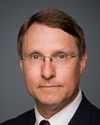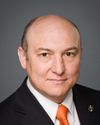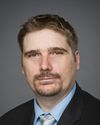Defence Research and Development Canada, DRDC, leverages other organizations' expertise, knowledge, and resources so that collaborations with partners create a more networked research environment. DRDC anticipates S and T and defence security challenges, and acts as the catalyst for an innovative defence and security research sector in Canada.
In short, our purpose is to provide DND and the Canadian Armed Forces the best advice, the best knowledge, and the best solutions possible. Our staff are absolutely unique in their knowledge of the business of defence, and they have first-hand knowledge of theatres of operation and of the challenges faced by the Canadian Armed Forces.
When the war in Afghanistan became the primary effort of the Canadian Armed Forces, DRDC refocussed its program of work to help achieve operational objectives overseas and to provide science and technology expertise that would save lives. More than 25 DRDC personnel, and I might add civilians, have been deployed in Afghanistan to provide science and technology support in theatre. Some of our staff have been decorated for their service in support of Canadian Armed Forces missions. Our experience in theatres of operations has informed our work in a range of areas, including research on operational injuries.
I'd like, Mr. Chair, to briefly give a couple of examples of scientific work that has been accomplished or initiated since Afghanistan, areas where DRDC and the scientific community have contributed knowledge and solutions.
In Afghanistan we saw increased use of improvised explosive devices, IEDs, which resulted in the increase of the incidence of blast-induced injuries and associated trauma. DRDC has developed an integrated blast injury research program, which delivers operationally relevant medical information with the intent to deepen DND's and the Department of Veterans Affairs' understanding of this type of trauma. That knowledge is important for the development of diagnostics and treatments, and to support informed decision-making.
We have developed combat incident analysis expertise, which is a unique evidence-based capability for enhancing soldier survivability and minimizing life-changing injuries. These developments have had real impact and informed vehicle upgrades and the fielding of new protective systems.
We're also using state-of-the-art technologies aimed at understanding mild traumatic brain injuries that will eventually lead to the development of better diagnostics, and perhaps more effective treatment.
We also understand that when our personnel return home from overseas, they face many challenges. As such, DRDC works to identify the positive and negative aspects of post-deployment reintegration experienced by Canadian Armed Forces members returning from Afghanistan. The post-deployment reintegration scale that our staff has developed aims to inform the work of the Canadian Armed Forces as they help our men and women in uniform adjust to work and family life when they return home.
Much of the work we do is performed in collaboration with others. The nature and complexity of the challenges members of the Canadian Armed Forces are faced with in theatre of operations, or returning from theatre, are such that we have developed new ways of accessing knowledge and of collaborating with other organizations.
Domestically, we work with partners across the department, including the chief of military personnel and the surgeon general. We work across government, including Veterans Affairs Canada, and across Canada, including universities and various institutes. For example, DRDC was instrumental in the creation of the Canadian Institute for Military and Veteran Health Research, also known as CIMVHR, which I believe has appeared in front of this committee.
CIMVHR is a consortium of 26 universities across Canada. We can thus tap into the tremendous knowledge and expertise that is spread across our universities in Canada, and leverage their knowledge base. DRDC also initiated last year a collaboration with the Canadian Institutes of Health Research. CIHR is the largest funding organization for medical research in Canada. We have worked with CIHR to provide funding that will allow Canadian scientists to bring their talent and expertise to focus on military health problems.
At the international level, DRDC works with NATO member countries that have faced similar challenges, either in Afghanistan or elsewhere in the world. DRDC has many scientists who are leading groups and panels in the Five Eyes science and technology community.
One example of our work with our allies is medical countermeasures, medical measures to protect military members from harm in terms of chemical toxins, bacteriological threats. Canada has played a leading role in forming the Medical Countermeasures Consortium with the U.S., Australia, and the U.K., to optimize operational performance in health protection.
Through the advancement of medical knowledge, monitoring, and detection capabilities and treatments against chemical, biological, and radiological threats, the Canadian Armed Forces have greatly improved protective, diagnostic and therapeutic capabilities.
In closing, I would like to say that I am proud of the accomplishments of the dedicated staff in my organization and at DRDC. We will continue to work with the Canadian Armed Forces to provide them with the unique, essential and strategic science and technology expertise that has, and will continue to, save lives.
I thank you for inviting me. My colleagues and I will be happy to answer questions.











